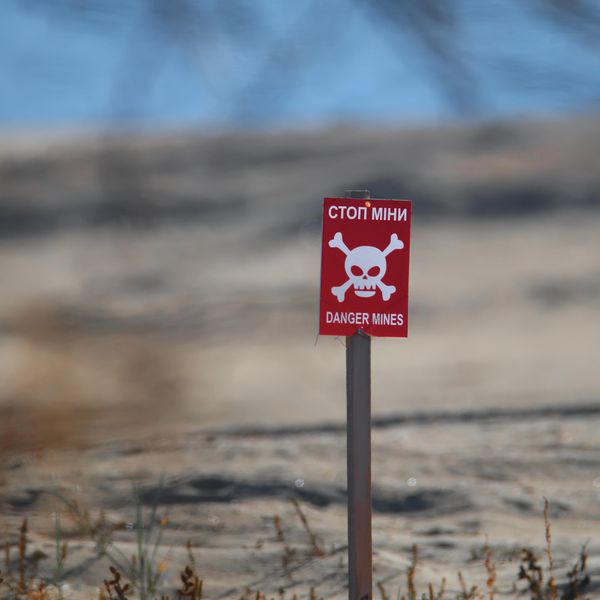A new report and satellite imagry shows that the Chinese government has continued to expand the number of prison camps in Xinjiang holding many of the country’s Muslim minority Uyghur population, despite the ruling Communist Party’s insistence that the “re-education” camps therehave been closing and the detainees “graduating.”
According to the Australian Strategic Policy Institute, there are 380 suspected prisons in the province, with 61 identified as having expanded over the last year, and 14 still growing.
“Evidence suggests that many extrajudicial detainees in Xinjiang’s vast ‘re-education’ network are now being formally charged and locked up in higher security facilities, including newly built or expanded prisons,” lead researcher Nathan Ruser wrote in the report.
The camps are part of President Xi Jinping’s broad campaign of repression aimed at enforcing ideological conformity throughout China, but it is particularly harsh in Xinjiang. Over the weekend, Xi said that his policies there “make a shared awareness of Chinese nationhood take root deep in the soul” and were “totally correct.”
The question is what can the current administration or future one do about it while recognizing the limits of American power?
The campaign against Uyghurs began in 2009, after attempts to suppress their ethnic identity eventually triggered what became the Urumqi riots. The regime blamed “separatists” and Islamists for the violence.
Repression redoubled around six years ago when the Chinese Communist Party began to create the ultimate totalitarian state in Xinjiang. Last year CNN reported on “surveillance cameras about every 150 feet, monitoring people’s faces and daily routines. Mobile police checkpoints popped up at random throughout the region, leading to long lines on public roads. At the checkpoints, and sometimes randomly on the street, police officers stopped people to ask for their ID cards and occasionally demanded to plug unidentified electronic devices into cellphones to scan them without explanation.” As detentions rose, some of these measures were eventually reduced in some communities.
There also is a systematic campaign to extinguish Uyghur culture. Respecting Muslim tenets, such as dress code, praying, and fasting, has reportedly resulted in threats and punishment. Since 2014 Han Chinese have been encouraged to move to Xinjiang; as many as a million have been essentially quartered in Uyghur homes to act as spies and enforcers. According to an Associated Press investigation in June, the government has conducted forced birth control measures, including abortions and sterilizations, to supress the minority population there.
Eventually the regime decided to “re-educate” much of the population, hence the prison camps. (These are not “concentration camps” of the Nazi variety since prisoners are not murdered.) While indoctrination — in Han identity and communist ideology — is the prime purpose of the camps, inmates have been reportedly subjected to multiple forms of abuse.
The regime has claimed that the large compounds situated behind high walls topped with barbed wire and patrolled by armed guards are merely vocational training centers. Official tours were highlighted by inmates singing “if you're happy and you know it clap your hands” under the watchful eyes of their minders.
Even after formal release, many Uyghurs end up in other forms of de facto confinement. Explained the Australian Strategic Policy Institute: “Under conditions that strongly suggest forced labor, Uyghurs are working in factories that are in the supply chains of at least 83 well-known global brands in the technology, clothing and automotive sectors, including Apple, BMW, Gap, Huawei, Nike, Samsung, Sony and Volkswagen.”
Estimates of the number of Uyghurs officially incarcerated run a million or more, though the total obviously is impossible to verify and has been criticized by some as an exaggeration. Nevertheless, the camps evidently exist. Firsthand reports by those released confirms the facilities’ malign purpose.Indeed, Beijing has treated family members in Xinjiang as hostages to stifle criticism from emigres.
Explained Deutsche Welle: “Uyghurs who fled to the US and Europe have told DW that Chinese authorities are trying to suppress the activism of the overseas Uyghur community by going after family members still living in China. Activists said that their released family members were discouraging them from protesting against the internment program.”
The New York Times’ published leaked materials as “The Xinjiang Papers” last November, reporting that, “Even as the government presented its efforts in Xinjiang to the public as benevolent and unexceptional, it discussed and organized a ruthless and extraordinary campaign in these internal communications. Senior party leaders are recorded ordering drastic and urgent action against extremist violence, including the mass detentions, and discussing the consequences with cool detachment.”
Beijing attempted to diffuse criticism by arguing that the camps would close as they fulfilled their purpose. Indeed, some of the older facilities have been emptied and abandoned. However, as the new study by ASPI reports, their findings “contradict Chinese officials’ claims that all ‘trainees’ from so‑called vocational training centers had ‘graduated’ by late 2019.”
As should be painfully evident, there is little Washington can do about this. Despite substantial Western criticism, Xi declared over the weekend that the Xinjiang policy was a “success” and now a “favorable setting of social stability with the people living in peace and contentment.”
Absent war it is impossible to force any state to comply with American human rights standards. The task is even more difficult when confronting a rising, nationalistic power with the world’s second largest economy and conventional military.
Nor are sanctions a serious option. So far the Trump administration’s maximum pressure campaigns against Cuba, Iran, North Korea, Syria, and Venezuela are a complete bust. A similar effort certainly won’t work against China. Indeed, Washington has had difficulty rounding up international support to simply criticize the PRC’s crackdown in Hong Kong. The administration has sanctioned CCP apparatchiks for their role in oppressing the Uyghurs, but this is faux action for the cameras. Xi is not going to close the camps because some of his minions cannot visit America.
Then what?
Whoever is elected November 3 should continue to draw attention to the Uyghurs’ plight. However, this will be most effective if done as part of a broad international effort rather than as part of a partisan political campaign. The U.S. should make a diplomatic push for Muslim majority states to speak out.
The next administration also should rally support to protect overseas Uyghurs from Chinese pressure. Attempts to intimidate Uyghurs living in the U.S. and elsewhere contradict Beijing’s demand for non-interference in the PRC. Perhaps a multi-national threat of narrow economic sanctions, expulsion of Chinese diplomats and journalists, and other targeted steps would deter the PRC.
Also appropriate is barring reliance on what is effectively slave labor. The U.S. Customs and Border Protection recently acted against goods thought to be produced by coerced Uyghur workers. The prohibition should be international.
Finally, people should not wait on government. They should organize to protest and embarrass Beijing and its enablers, especially in the Muslim world. Activists also should engage Chinese people outside of government, highlighting how the mistreatment of Uyghurs has blighted the PRC’s reputation.
Beijing’s brutal repression of the Uyghurs is a human rights atrocity. However, good policy rests on recognition of the limits of American power. The U.S. should build collective international support and set narrow, realistic objectives. The objective should be to help real people rather than score political points.
















